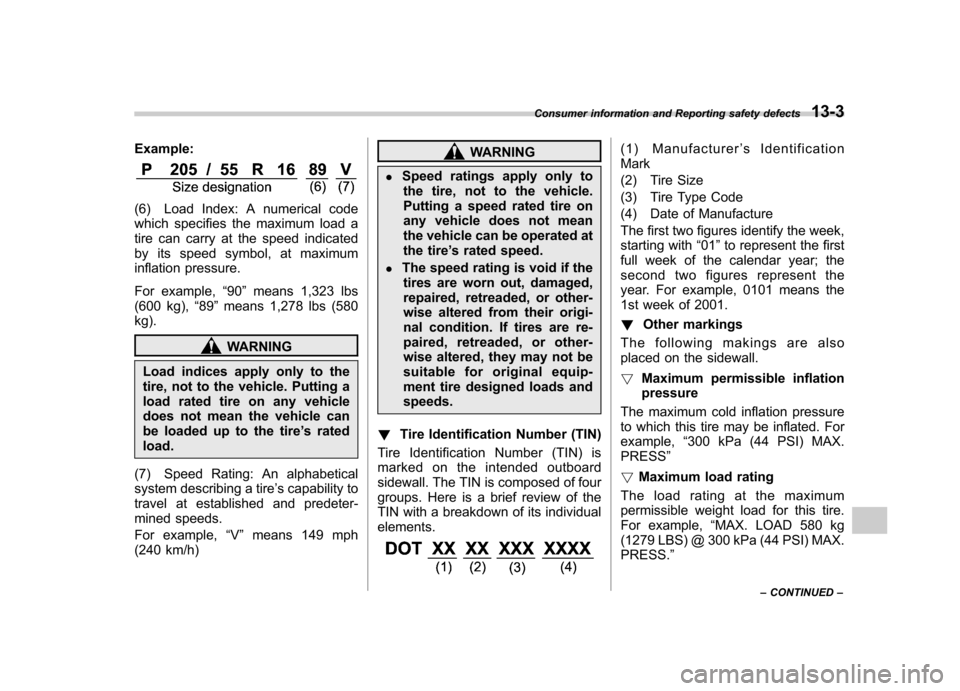2007 SUBARU IMPREZA WRX tire type
[x] Cancel search: tire typePage 342 of 364

13-2Consumer information and Reporting safety defects
For U.S.A.
The following information has been
compiled according to Code of Fed-
eral Regulations “Title 49, Part 575 ”. Tire information &
Tire labeling
Many markings (e.g. Tire size, Tire
Identification Number or TIN) are
placed on the sidewall of a tire by tire
manufacturers. These markings can
provide you with useful information on
the tire. ! Tire size
Your vehicle comes equipped with P-
Metric tire size. It is important to
understand the sizing system in se-
lecting the proper tire for your vehi-
cles. Here is a brief review of the tire
sizing system with a breakdown of its
individual elements. ! P Metric
With the P-Metric system, Section
Width is measured in millimeters. To
convert millimeters into inches, divide
by 25.4. The Aspect Ratio (Section
Height divided by Section Width)
helps provide more dimensional in-
formation about the tire size. Example:
(1) P = Certain tire type used on
light duty vehicles such as passenger
cars
(2) Section Width in millimeters
(3) Aspect Ratio (= section height
7
section width).
(4) R = Radial Construction
(5) Rim diameter in inches ! Load and Speed Rating Descrip- tions
The load and speed rating descrip-
tions will appear following the size
designation.
They provide two important facts
about the tire. First, the number
designation is its load index. Second,
the letter designation indicates thetire ’s speed rating.
Page 343 of 364

Example:
(6) Load Index: A numerical code
which specifies the maximum load a
tire can carry at the speed indicated
by its speed symbol, at maximum
inflation pressure.
For example,“90 ”means 1,323 lbs
(600 kg), “89 ”means 1,278 lbs (580
kg).
WARNING
Load indices apply only to the
tire, not to the vehicle. Putting a
load rated tire on any vehicle
does not mean the vehicle can
be loaded up to the tire ’s rated
load.
(7) Speed Rating: An alphabetical
system describing a tire ’s capability to
travel at established and predeter-
mined speeds.
For example, “V ” means 149 mph
(240 km/h)
WARNING
. Speed ratings apply only to
the tire, not to the vehicle.
Putting a speed rated tire on
any vehicle does not mean
the vehicle can be operated at
the tire ’s rated speed.
. The speed rating is void if the
tires are worn out, damaged,
repaired, retreaded, or other-
wise altered from their origi-
nal condition. If tires are re-
paired, retreaded, or other-
wise altered, they may not be
suitable for original equip-
ment tire designed loads and speeds.
! Tire Identification Number (TIN)
Tire Identification Number (TIN) is
marked on the intended outboard
sidewall. The TIN is composed of four
groups. Here is a brief review of the
TIN with a breakdown of its individual
elements.(1) Manufacturer ’s Identification
Mark
(2) Tire Size
(3) Tire Type Code
(4) Date of Manufacture
The first two figures identify the week,
starting with “01 ”to represent the first
full week of the calendar year; the
second two figures represent the
year. For example, 0101 means the
1st week of 2001. ! Other markings
The following makings are also
placed on the sidewall. ! Maximum permissible inflation
pressure
The maximum cold inflation pressure
to which this tire may be inflated. For
example, “300 kPa (44 PSI) MAX.
PRESS ”
! Maximum load rating
Theloadratingatthemaximum
permissible weight load for this tire.
For example, “MAX. LOAD 580 kg
(1279 LBS) @ 300 kPa (44 PSI) MAX.
PRESS. ”
Consumer information and Reporting safety defects
13-3
– CONTINUED –
Page 344 of 364

13-4Consumer information and Reporting safety defects
WARNING
Maximum load rating applies
only to the tire, not to the
vehicle. Putting a load rated tire
on any vehicle does not mean
the vehicle can be loaded up to
the tire ’s rated load.
! Construction type
Applicable construction of this tire.
For example, “TUBELESS STEEL
BELTED RADIAL ”
! Construction
The generic name of each cord
material used in the plies (both side-
wall and tread area) of this tire.
For example, “PLIES: TREAD 2
STEEL + 2 POLYESTER SIDEWALL
2 POLYESTER ”
! Uniform Tire Quality Grading
(UTQG)
For details, refer to “Uniform tire
quality grading standards ”in this
chapter.
Page 352 of 364

13-12Consumer information and Reporting safety defects
Uniform tire quality grading standards
This information indicates the relative
performance of passenger car tires in
the area of treadwear, traction, and
temperature resistance. This is to aid
the consumer in making an informed
choice in the purchase of tires.
Quality grades can be found where
applicable on the tire sidewall be-
tween tread shoulder and maximum
section width. For example:
Treadwear 200 Traction AA Tem-
perature A
The quality grades apply to new
pneumatic tires for use on passenger
cars. However, they do not apply to
deep tread, winter type snow tires,
space-saver or temporary use spare
tires, tires with nominal rim diameters
of 12 inches or less, or to some limited
production tires.
All passenger car tires must conform
to Federal Safety Requirements in
addition to these grades. &
Treadwear
The treadwear grade is a comparative
rating based on the wear rate of the
tire when tested under controlled
conditions on a specified government
test course.
For example, a tire graded 150 would
wear one and one-half (1-1/2) times
as well on the government course as
a tire graded 100. The relative perfor-
mance of tires depends upon the
actual conditions of their use, how-
ever, and may depart significantly
from the norm due to variations in
driving habits, service practices and
differences in road characteristics and
climate. & Traction AA, A, B, C
The traction grades, from highest to
lowest, are AA, A, B and C. Those
grades represent the tire ’s ability to
stop on wet pavement as measured
under controlled conditions on speci-
fied government test surfaces of
asphalt and concrete. A tire marked
C may have poor traction perfor- mance.WARNING
The traction grade assigned to
this tire is based on straight-
ahead braking traction tests,
and does not include accelera-
tion, cornering, hydroplaning, or
peak traction characteristics.
& Temperature A, B, C
The temperature grades are A (the
highest), B, and C, representing thetire ’s resistance to the generation of
heat and its ability to dissipate heat
when tested under controlled condi-
tions on a specified indoor laboratory
test wheel. Sustained high tempera-
ture can cause the material of the tire
to degenerate and reduce tire life, and
excessive temperature can lead to
sudden tire failure. The grade C
corresponds to a level of performance
which all passenger car tires must
meet under the Federal Motor Vehicle
Safety Standards No. 109. Grades B
and A represent higher levels of
performance on the laboratory test
wheel than the minimum required by
Page 361 of 364

14-8Index
Specifications ............................................................ 12-2
Speedometer ....................................................... 3-7, 3-11
SRS
Frontal airbag ........................................................ 1-39
Side airbag ........................................................... 1-50
SRS airbag (Supplemental Restraint System airbag) ... 4, 1-35
SRS airbag system
Monitors. ............................................................... 1-55
Servicing ............................................................... 1-56
Warning light ......................................................... 3-14
Starting the engine ....................................................... 7-7
State emission testing (U.S. only) .................................. 7-5
Steering wheel
Power ................................................................... 7-20
Tilt ....................................................................... 3-35
STI front lip spoiler ..................................................... 8-28
Stopping the engine ..................................................... 7-8
Storage compartment ................................................... 6-4
Sun shade ................................................................ 2-26
Sun visors ................................................................... 6-3
Supplemental Restraint System airbag (SRS) ................ 1-35
Synthetic leather upholstery ........................................ 10-5
T
Tachometer ......................................................... 3-7, 3-12
Temperature gauge .............................................. 3-8, 3-13
Temperature warning light (AT OIL TEMP) ..................... 3-17
Temporary spare tire .................................................... 9-2
Tie-down hooks ......................................................... 9-12
Tilt steering wheel ...................................................... 3-35 Tire
Chains .................................................................. 8-11
Inspection ............................................................ 11-30
Pressures and wear .............................................. 11-31
Replacement. ....................................................... 11-34
Rotation .............................................................. 11-34
Tires ......................................................................... 12-5
Types .................................................................. 11-30
Tires and wheels ...................................................... 11-30
Top tether anchorages ................................................ 1-32
Towing ...................................................................... 9-11
All wheels on the ground ......................................... 9-14
Flat-bed truck ......................................................... 9-13
Tie-down hooks ...................................................... 9-12
Weight .................................................................. 8-20
Trailer
Hitch ..................................................................... 8-17
Hitches .................................................................. 8-23
Towing .................................................................. 8-20
Towing tips ............................................................ 8-25
Trunk lid .................................................................... 2-20
Release handle ...................................................... 2-21
Trunk light ............................................................... 11-52
Turn signal Indicator lights ........................................................ 3-20
Lever .................................................................... 3-24
U
Under-floor storage compartment .................................. 6-12